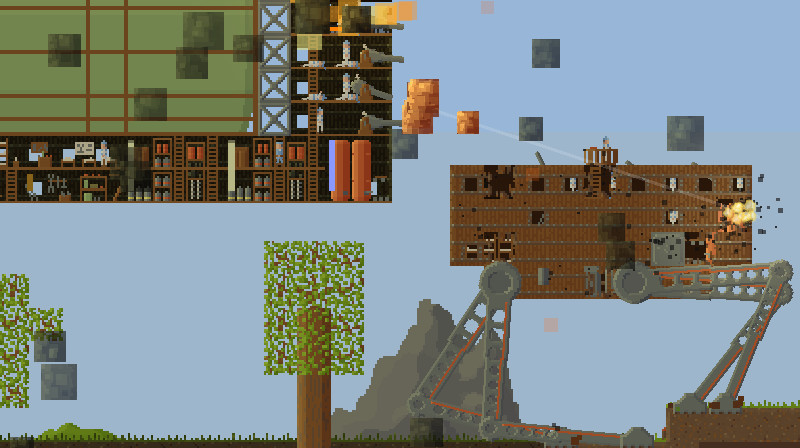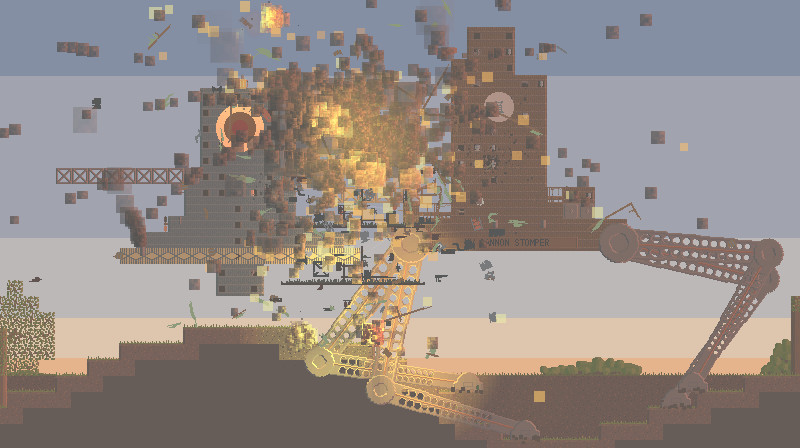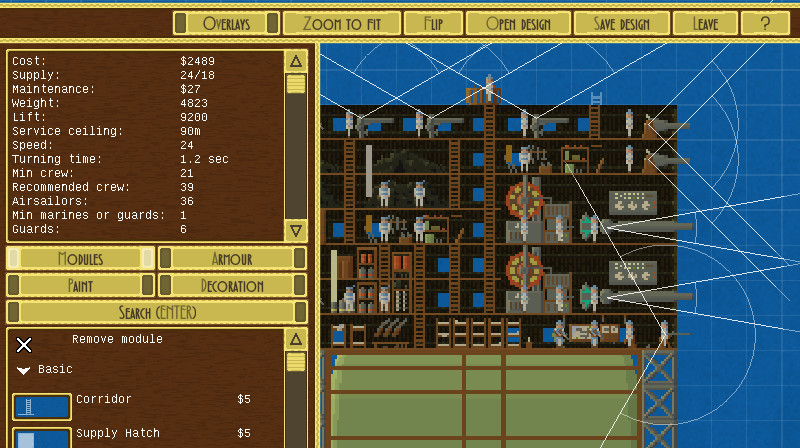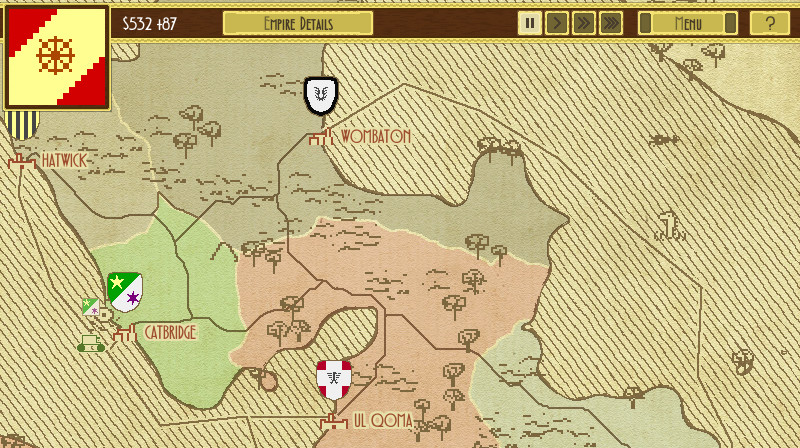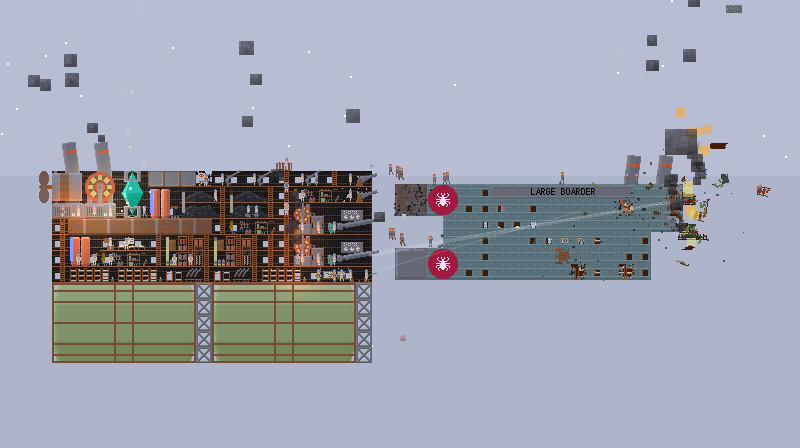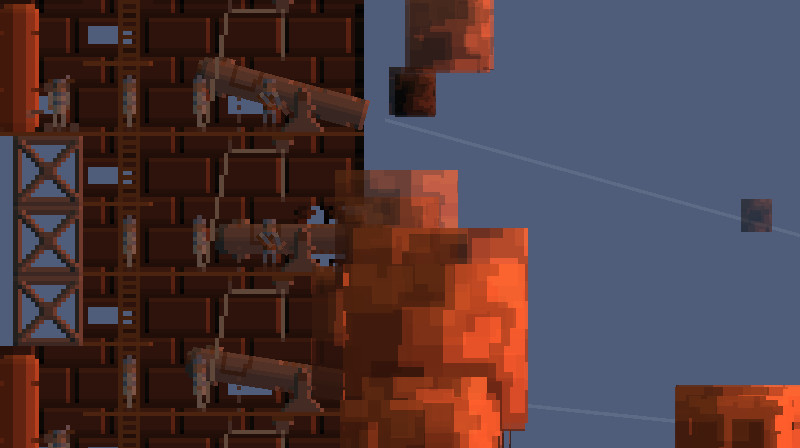In the game, ships are viewed side-on, and their modules are operated by individual crew members. During combat, players give high-level commands to a small fleet, positioning their ships, ramming and boarding others. Ships and terrain are fully destructible: they can catch fire, explode, break apart, and fall. Players can also compete against one another in Internet and LAN matches.
The ships are highly detailed, teeming with sailors moving around at their individual tasks, like an ant farm or a cut-away drawing. The player's choices in ship layout are crucial, and an important part of the game is exploring the design space of different airships and their matching tactics.
As previously mentioned, I really enjoy the history blog ACOUP . One of the things it's brought up recently is the difference between strategy, operations, and tactics in war. I want to talk about these in terms of how they map onto computer games, including mine.
Strategy is about what you're trying to achieve, and the big-picture of how you are going to achieve it. "Conquer the world with my unstoppable legions of doom" is a strategy, if a simple one.
Operations is about implementing strategy: troop movements, logistics, all that stuff. "March doom legion XVI towards the capital of the Alliance of Really Nice People" is operations.
Finally, tactics is about how to actually fight effectively: "Use doom trooper death cannons to vaporize enemy soldiers" is tactics.
Under this terminology, a lot of strategy games are actually mostly about operations, but the other two layers also come into play.
In Civilization games, the strategy layer is the different victory conditions and diplomacy between players. Because it's a game, the aim of your strategy is going to be "win the game", but it may be "win the game by conquering all enemy capitals, starting with the French next door" or "win the game by cultural dominance by cranking out lots of wonders". The meat of the game is in controlling operations, which means building units and moving them. Tactics are the fights between individual units, and are abstracted away.
In Starcraft, the strategy layer is entirely determined by the plot. The player does not make strategic decisions, but rather they are given operational goals as mission victory conditions. Gameplay consists of both operations (build up an economy, expand, build units, move them into position to fight) and tactics (give commands to your units during fights). Note how the terms "macro" and "micro" nicely map onto "operations" and "tactics".
In XCOM, the strategy is also told through the plot, and is roughly "use small high-tech squads to disrupt and investigate alien activities to determine and stop their evil plans". Again, you have no control over the strategy: You can't, for example, employ the strategies of "use normal national military forces to attack alien strongholds" or "ally with the alien invaders". Gameplay consists of both operations and tactics, but here it's split into two distinct modes: upgrading your base, researching technologies, and picking missions is operations, while individual missions are tactical.
So finally in Airships, especially with the upcoming diplomacy update, all three layers will be represented: Like in Civ, there are multiple victory conditions and free choice as to whom to attack and whom to ally with, giving you control of strategy. And operations means building airships, landships, and buildings, and moving your forces to attack and defend. Finally, the combat mode is where the tactics happen.
This is not to say that Airships is the best game out of those because it does all of these three layers. It's a design decision which layers you give the player control over. But I found it interesting to think about, especially because in terms of code, there are three AI modules that nicely map to these layers: a strategic one that handles diplomacy and victory plans, an operational one that builds and moves things, and a tactical one that commands ships in combat.
Minimum Setup
- OS: Ubuntu/Debian/Mint
- Processor: 1.8 Ghz+Memory: 256 MB RAM
- Memory: 256 MB RAM
- Graphics: 1 GB VRAM+
- Storage: 1 GB available spaceAdditional Notes: Not currently compatible with Intel HD graphics controllers. May run on other Linux distros. but no guarantees.
Recommended Setup
- OS: Ubuntu/Debian/Mint
- Processor: 2.2Ghz+ Dual-coreMemory: 2 GB RAM
- Graphics: 2 GB VRAM+Network: Broadband Internet connection
- Storage: 1 GB available spaceAdditional Notes: Not currently compatible with Intel HD graphics controllers. May run on other Linux distros. but no guarantees.
[ 6425 ]
[ 3822 ]
[ 2906 ]

